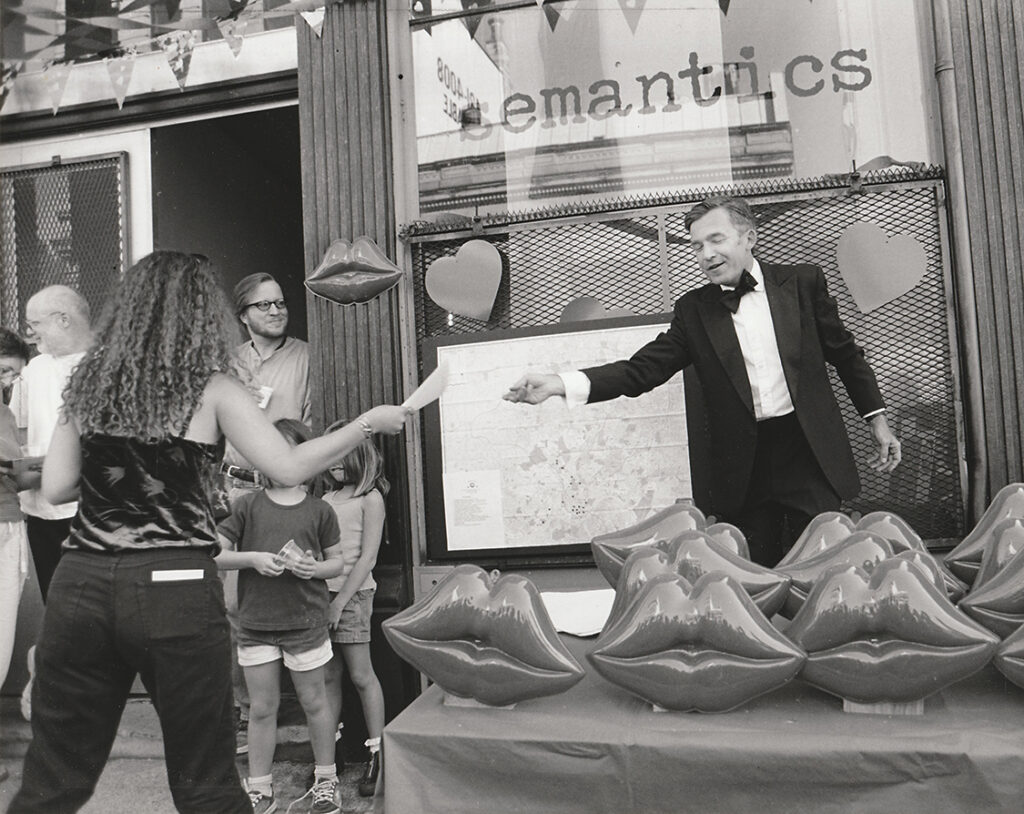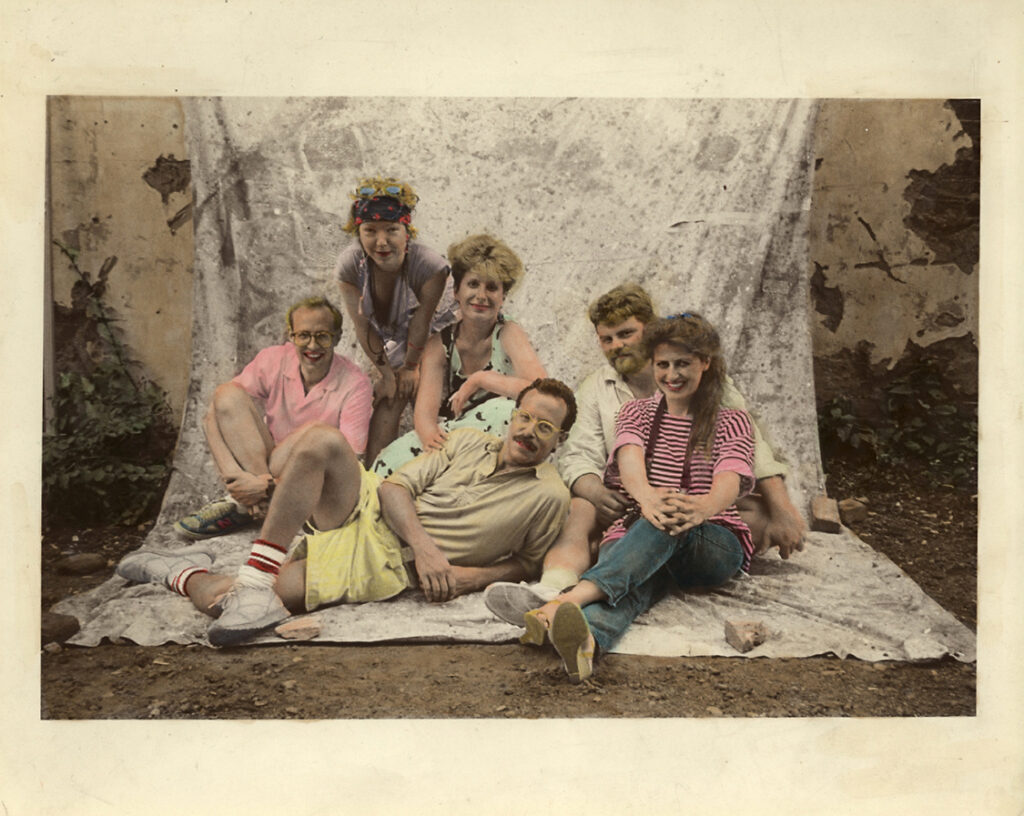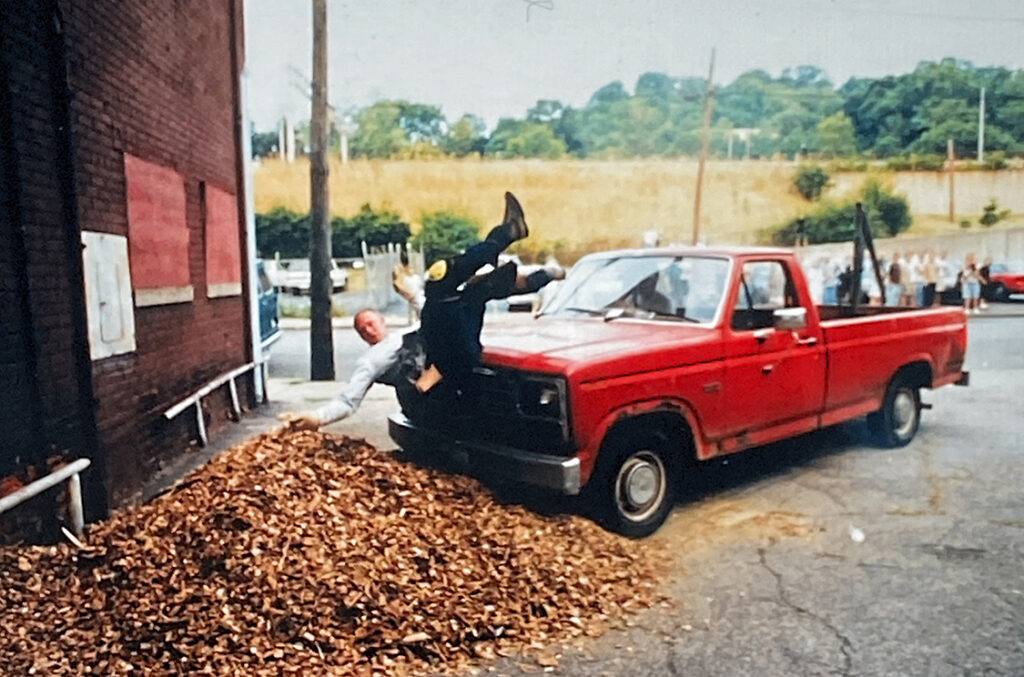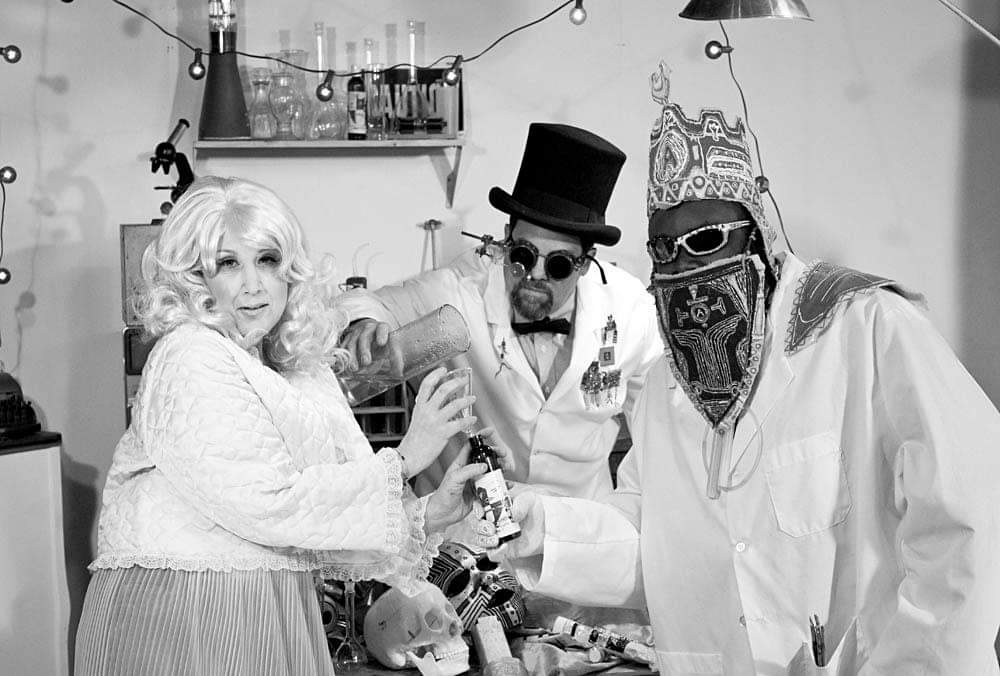Call for Entry Highlight: Artist Run
Posted on August 28, 2024
For the 2024 iteration, FotoFocus announced a new Biennial initiative: Call for Entry Selections. These six selected projects highlight talent from the region’s artists and curators as part of the first large-scale regional Call for Entry in the Biennial’s history. Each month leading up to the Biennial, a Call for Entry project will be highlighted. Learn more about Artist Run, The Continuing Legacy of Cincinnati’s Artist-Run Spaces.
Artist Run, developed by Britni Bicknaver and Calcagno Cullen, is a photographic archive and audiovisual history tour of underground art spaces in Cincinnati, including a physical bus tour, with a live host and interview clips from artists and curators during October. The bus tour will be a performative art experiment, very much in the spirit of the DIY spaces being recognized with this project.
Featured Venues: Anytime Dept., C.A.G.E., DiLeia, Images, The Mockbee, Neo Ancestralists, Publico, Semantics, Thundersky, VOLK
Bus Tours:
October 4: 7pm & 9pm
October 5: 7pm & 9pm
October 11: 7pm & 9pm
October 12: 7pm & 9pm
Tours begin at Wave Pool at 7pm and 9pm, with a reception between tours from 8–9pm to discuss the project, share stories, and connect the artist-run community. Receptions are open to the public. Registration is required via artistruncincy.com.

. . .
By: Maria Seda-Reeder
Archiving Ephemeral Artists Run Spaces: documenting the artist-driven gallery spaces in Cincinnati, one site at a time
Call it nostalgia. Call it community pride. Call it this author’s advanced age showing, but to say that Cincinnati has a rich and diverse history of artist run spaces is an understatement.
In the span of three generations that involved decades of city and property disinvestment, resourceful artists swooped into locations like Brighton, the West End, Over-the-Rhine, Northside, and Camp Washington with their sweat equity, youthful optimism, and know-how to spruce up locations that were previously considered otherwise “unsavory” by the larger majority. [It is perhaps also no coincidence that those same neighborhoods are now experiencing major surges of big investment, but that is another story for another day, fair reader.]
As a result, Cincinnati has an evergreen history of ad hoc, DIY locations for viewing and, (this is perhaps the most important part,) experiencing cutting edge, experimental art. The kind of work that challenges the expectations of the Art Institution, and is made by artists who are richer in ideas, enthusiasm and willful naïveté, then they are in professional opportunities.
Artists Britni Bicknaver and Calcagno (Cal) Cullen know a lot about Cincinnati’s Artist Run Spaces (ARS). The subject of their upcoming FotoFocus audio/online archive of non-traditional artist-driven exhibition projects, both have been involved with several ARS in the past.
Bicknaver was a founding member of Publico Gallery (2003-2008) in OTR, and currently works at Wave Pool, an artist-led gallery in Camp Washington that project partner Cullen founded in 2014. A social practice artist who works with communities, Cullen served as the former Executive Director of Wave Pool before leaving to work on the granting side of such endeavors. She reached out to Bicknaver, an interdisciplinary artist who works with sound, to assist in shining a light on and cataloguing for future posterity the various ARS in Cincinnati from the past six decades, for this web-based and in-person archive the two are creating.

In the About section of their website, the two explain why this project was necessary: “Cincinnati has been an incubator for experimental, outsider, and DIY arts activities. Some would argue that it’s because we’re in a flyover state, or perhaps due to a lack of robust institutional support for local artists, or maybe it’s simply because of a lack of a strong collector and commercial gallery system that artists here are more willing to step outside of the conventional white-walled box to create unique art experiences. Whatever the reason, Cincinnati has a history of artist-run spaces in spades.”
But the project is more than just an online repository of information. Of the more than eighty ARS they’ve catalogued so far, the two artists are also creating an additional ten physical, photo-driven installations at former/current sites included in the archive, complete with QR codes to interviews they’ve collected with dozens of participating local artists, allowing interested parties to use a map to self-guide through a tour of these various locations, even after the Biennial is over.
During FotoFocus programming, Bicknaver and Cullen will also host a series of tours to take visitors to those sites in a trolley, including local art scene character Sue Said as host extraordinaire, offering commentary and philosophy during travel between destinations. Bicknaver is creating audio segments for the tour, while Cullen is producing a poster-sized print, to live on as a tangible record of these stories.
Bicknaver and Cullen’s project is a necessary labor of love on behalf of an endeavor, which often operates contrary to any forms of traditional financial support. It is much harder to apply and receive fiscal sponsorship without official 501c3 nonprofit status or a governing Board of Directors, so many DIY art spaces’ tenures are brief—fleeting in the context of the larger history of art.
Therefore, many of these ephemeral spaces, without some kind of documented record, are often completely lost to history. Though they may occupy a temporary rented residence of an artist, or a third, more studio-like space, to have a permanent location for any ARS is quite uncommon.
All of these endeavors occupy niches within the art world itself, and reflect the ever-moving target of contemporary art’s avant garde. To some extent, creating art outside of the confines of traditional art institutions like museums and commercial galleries, is the only way that an artist can truly be free from the creative expectations of a Board or Director—or even to a public. This lack of oversight also creates a concomitant lack of censorship, which is a prerequisite for artists who are experimenting and testing out radical concepts.

“These spaces are very rare creatures,” Bicknaver says. “Very few artists running these spaces expect to turn a profit, and in our culture that is just so rare,” she explains.
As is widely documented, artists tend to act as the first wave for neighborhood revitalization—often identifying areas that have been undervalued, and serving as first-round validators of a local area’s vitality.
That creatives often spend their own precious funds, invite strangers into their private domestic spaces, and/or put in countless labor hours of their own time, knowing that they will likely end in a deficit at the end of the project—all of these qualities are what make Artist Run Spaces so unique and crucial to the development of a vibrant art scene in any city.
But it’s not just that Artist Run Spaces can happen anywhere. It takes a special combination of circumstances for ARS to really flourish: available property, the optimism of youth, and a willingness to get things done without institutional validation.
Bicknaver and Cullen’s project is also important because Artist Run Spaces have been happening here. In Cincinnati: a town where so many artists and arts institutions were pinched by the Culture Wars of the 1990s, there is a long memory for creative censorship. But there’s a limit to how far any artist-run project can keep going without sustained public or private funding. And opportunities for funding often conflict with artists’ need for freedom of expression. So there are many ARS that only lasted a short time.
With our region’s many arts-focused higher education institutions (The Art Academy of Cincinnati, UC, Mount St. Joe, and XU—just to name a few,) Cincinnati has rarely ever had a deficit of artists with interesting ideas. Couple that with our (now rapidly vanishing) former wealth of affordable properties, and you have the two most crucial elements to any art scene: affordable space, and youthful ingenuity.
When asked what makes an ARS successful, the project architects gave very pragmatic answers.
“If success means lasting a long time, maybe it’s having a really cool landlord for a long time, like Semantics,” Cullen states; mentioning the Brighton gallery which ran for twenty-three years with little more than a dedicated volunteer group of artists, and a mason jar for donations to their paint and wall spackle funds. They were able to keep their radical business model (or lack thereof) thanks to the kindness of Brighton property owner Fred Lane, who gave them more than two decades of free rent of the gallery space.

But there are other, just as influential art spaces that lasted mere months.
Bicknaver cites VOLK/c.s.p.i (contemporary summer project initiative,) run by artists Joseph Winterhalter, Mark Flanagan, Tim McMichael, and Zoltan Faltay, as something she saw when she was in high school that really impacted her development as an artist. The temporary artist-driven project, which ran for two months in 2000 featured no less than 4 group exhibitions, 10 evenings of poetry, 13 musical performances, and several film presentations over the course of their short run. That is more than some larger institutions with much deeper pockets accomplish in a full year.
Bicknaver explained what makes an ARS successful to her. “I think just the ability to have a space and open a show makes it successful, since it takes a lot,” she says. “For a lot of artists that are up-and-coming, having a public space to show and a card with your name on it is huge,” she states. “It’s more than enough.”
And their list of spaces and interviewees reads like a veritable who’s-who of Cincinnati artists and arts professionals. If you have ever participated in the local art scene of the past quarter of a century, you might recognize such influential names in their archive as Matt Distel (DiLeia Gallery,) Jimi Jones (Neo-Ancestralists/Cincinnati Arts Consortium), Carissa Barnard (The Mockbee), Keith Benjamin and Bill Ross (Visionaries + Voices/ThunderSky,) and David Dillon and Andy Marko (Semantics) who all shared their experiences with these kinds of endeavors—just to name a few.
“Success doesn’t necessarily always mean becoming a sustainable nonprofit organization or a for profit business,” Cullen says.
“To me, success is supporting your community of artists and doing radical things,” she explains.
“There definitely are instances where these artist run spaces transitioned into sustainable organizations. But the ephemerality of these spaces is part of their magic,” Cullen states with a sparkle in her eyes.
Organizers of Cincinnati Artist Run Spaces, past and present, can submit information to the ongoing archive at the website: artistruncincy.com/contribute
